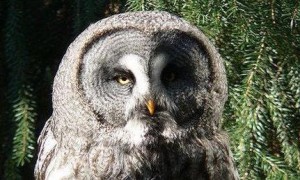
September 26, 2010

Using language that is less than precise can be very confusing. I’ve read the article below, by John Richardson, published at the “Care 2 Make A Difference” site a few times. At first, I couldn’t tell if it was a new species or subspecies that was found, although the scientific name given would suggest a subspecies.
Elsewhere, it is rather clear that a subspecies, Strix nebulosa yosemitensis, Yosemite’s great gray owl, has been found. Prior scientific research on great gray owls shows that only two other subspecies have been recognized: Strix nebulosa nebulosa in North America and Strix nebulosa lapponica in Europe and Asia.
The great gray owls in and around Yosemite National Park have been found to be a distinct subspecies. Researchers captured 29 of the large owls in the Sierra Nevada, (they have five-foot wingspans) and took blood samples. Captured owls were held bare-handed and the owls were hooded to reduce stress. Also blood samples from owls in Canada and southern Oregon were collected.
Analysis of blood samples using computers showed genetic codes differed enough the Sierra Nevada owls are distinct species. Scientists estimated the Sierra Nevada population has not interbred with the nothern populations for 26,700 years. Behavior differences such as nest site selection, migration patterns, and prey preferences were also observed.
Lead researchers on the project were John J. Keane of the U.S. Forest Service Pacific Southwest Research Station, and Holly B. Ernest and Joshua M. Hull of the Veterinary Genetics Laboratory at UC Davis. They suggested naming the Yosemite area great gray owls Strix nebulosa yosemitensis. The great gray owl species is named Strix nebulosa. In California great gray owls are listed by the state as an endangered species. There are just 150 of them within Yosemite National Park….
Image Credit: BS Thurnerhof
About Loren Coleman
Loren Coleman is one of the world’s leading cryptozoologists, some say “the” leading living cryptozoologist. Certainly, he is acknowledged as the current living American researcher and writer who has most popularized cryptozoology in the late 20th and early 21st centuries.
Starting his fieldwork and investigations in 1960, after traveling and trekking extensively in pursuit of cryptozoological mysteries, Coleman began writing to share his experiences in 1969. An honorary member of Ivan T. Sanderson’s Society for the Investigation of the Unexplained in the 1970s, Coleman has been bestowed with similar honorary memberships of the North Idaho College Cryptozoology Club in 1983, and in subsequent years, that of the British Columbia Scientific Cryptozoology Club, CryptoSafari International, and other international organizations. He was also a Life Member and Benefactor of the International Society of Cryptozoology (now-defunct).
Loren Coleman’s daily blog, as a member of the Cryptomundo Team, served as an ongoing avenue of communication for the ever-growing body of cryptozoo news from 2005 through 2013. He returned as an infrequent contributor beginning Halloween week of 2015.
Coleman is the founder in 2003, and current director of the International Cryptozoology Museum in Portland, Maine.
Filed under Avian Mysteries, Breaking News, CryptoZoo News, New Species